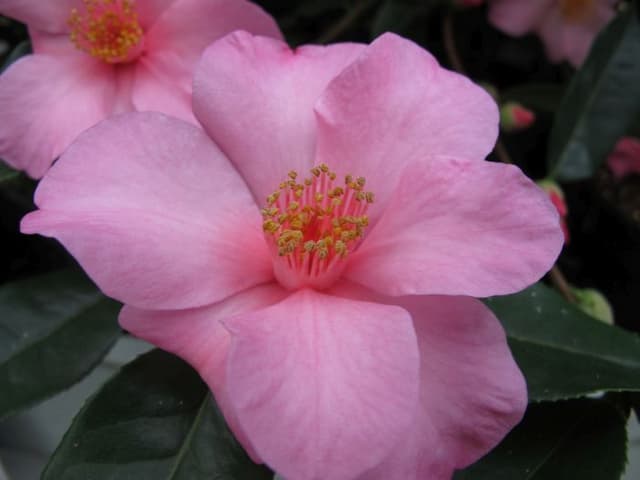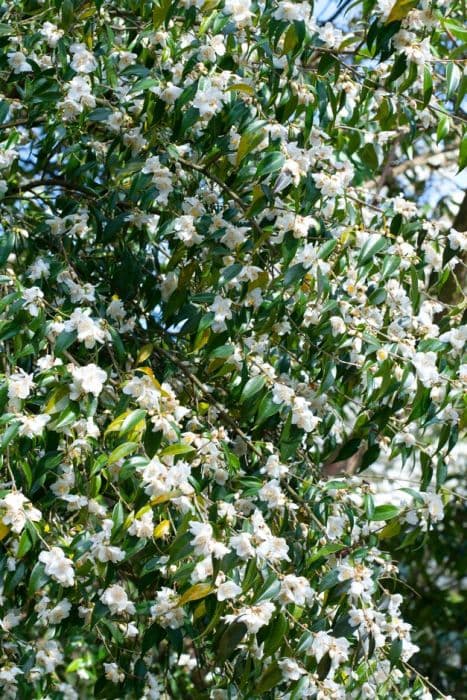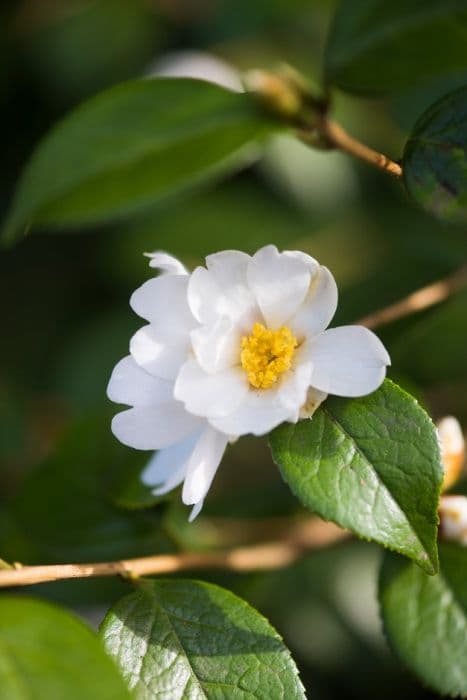Japanese Camellia Camellia japonica 'Rubescens Major'

ABOUT
Camellia japonica 'Rubescens Major', commonly known as the Japanese camellia, is an ornamental shrub known for its stunning and lush flowers. This variety is particularly admired for its large, rose-pink blooms that exhibit a rich, velvety texture. The petals offer a captivating display as they unfold in a formal double form, meaning they are densely layered in a symmetrical fashion, adding a touch of elegance to the floral presentation. At the center of each bloom, the petals may be slightly ruffled or even exhibit a hint of a spiral arrangement, which provides a beautiful depth and complexity to the flower. The glossy, dark green leaves provide a striking contrast to the vibrant pink flowers, further enhancing the visual impact of the shrub. Each leaf is leathery to the touch and has a smooth, almost polished look, which is typical of the species. The leaves are elliptical in shape with a pointed tip and finely serrated edges, contributing to the overall lush and healthy appearance of the plant. Throughout the blooming period, which typically occurs in late winter to early spring, the Japanese camellia becomes a focal point in the garden, with its flowers attracting the attention of onlookers and pollinators alike. Even when not in bloom, the plant maintains its ornamental value thanks to its evergreen nature, ensuring year-round interest. As a cultivated variety of the Japanese camellia, 'Rubescens Major' is enjoyed by gardeners not only for its aesthetic qualities but also for its ease of integration within diverse landscape designs, where it provides a splash of color and a touch of romance to the scenery.
About this plant
 Names
NamesFamily
Theaceae.
Synonyms
Japanese Camellia, Rose of Winter, Common Camellia.
Common names
Camellia japonica 'Rubescens Plena', Thea japonica 'Rubescens Major'.
 Toxicity
ToxicityTo humans
The Japanese Camellia (Camellia japonica 'Rubescens Major') is generally considered non-toxic to humans. There are no significant toxic effects reported from ingesting any part of this plant. However, it is important to note that while it is not toxic, any plant material consumed in excess can potentially cause gastrointestinal discomfort or other non-specific symptoms due to the natural defense mechanisms of the plants or simply from the fiber content.
To pets
The Japanese Camellia (Camellia japonica 'Rubescens Major') is also generally considered non-toxic to pets. Similar to its effects on humans, ingestion of this plant is not known to cause serious harm to pets. Nonetheless, consuming plant material can lead to mild symptoms such as vomiting or diarrhea in some animals, mainly due to mechanical irritation or sensitivity to the plant, not because of inherent toxicity.
 Characteristics
CharacteristicsLife cycle
Perennials
Foliage type
Evergreen
Color of leaves
Green
Flower color
Pink
Height
6-12 feet (1.8-3.6 meters)
Spread
6-10 feet (1.8-3 meters)
Plant type
Shrub
Hardiness zones
7
Native area
Japan
Benefits
 General Benefits
General Benefits- Ornamental Value: The Camellia japonica 'Rubescens Major', commonly known as 'Camellia', is prized for its large, showy flowers that add aesthetic appeal to gardens and landscapes.
- Long Blooming Season: Camellias have a long flowering period, which can last from late winter through spring, providing color during times when few other plants are in bloom.
- Versatility: Camellias can be used in a variety of landscapes as specimen plants, hedges, or container plants, making them versatile additions to many garden styles.
- Shade Tolerance: Camellias are well-suited to shaded areas, making them ideal for underplanting beneath tall trees or in shaded corners of gardens.
- Evergreen Foliage: As an evergreen, the Camellia maintains its glossy, dark green leaves year-round, offering continual visual interest even when not in bloom.
- Drought Resistance: Once established, Camellias have moderate drought tolerance, making them suitable for regions with occasional water shortages.
- Wildlife Attraction: The blooms can attract pollinators such as bees, which are vital for maintaining healthy ecosystems and for the pollination of other plants.
- Cultural Significance: Camellias have cultural importance in many Asian countries and can be used to add an element of Eastern beauty or to create Asian-themed gardens.
 Medical Properties
Medical PropertiesThis plant is not used for medical purposes.
 Air-purifying Qualities
Air-purifying QualitiesThis plant is not specifically known for air purifying qualities.
 Other Uses
Other Uses- Ink production: The petals of Camellia japonica 'Rubescens Major' can be used to make a natural dye, which in turn can be used to create inks for art and craft projects.
- Fabric dye: Similar to ink production, the petals can also be used to dye fabrics, providing a range of pink hues, depending on the concentration and fabric type.
- Photography: With its striking flowers, Camellia japonica 'Rubescens Major' serves as an excellent subject for botanical photography and artistic compositions.
- Latex substitute: In research, the leaf extract of Camellia has been explored as an eco-friendly substitute for synthetic latex in some industrial applications.
- Woodworking: The wood from Camellia japonica 'Rubescens Major' can be used for crafting small wooden items, such as handles and inlays, due to its fine grain.
- Culinary garnishing: Although typically non-edible, the flowers can be used for decorative plating in high-end cuisine, where they can be removed before consumption.
- Botanical illustration: Camellia japonica 'Rubescens Major' may be used as a subject for botanical illustrations and educational material because of its distinct floral characteristics.
- Floral candle making: The flowers can be embedded into clear candles to create ornamental items which showcase the beauty of the flowers when lit.
- Craft material: Dried and pressed petals of Camellia japonica 'Rubescens Major' can be used in scrapbooking and paper crafts for decoration.
- Natural confetti: Dried petals can be used as an eco-friendly alternative to traditional paper confetti at celebrations.
Interesting Facts
 Feng Shui
Feng ShuiThe plant_name is not used in Feng Shui practice.
 Zodiac Sign Compitability
Zodiac Sign CompitabilityThe plant_name is not used in astrology practice.
 Plant Symbolism
Plant Symbolism- Admiration: Camellias often represent deep admiration for someone. 'Rubescens Major', with its striking flowers, could symbolize a profound and focused appreciation for another's qualities.
- Perfection: With its flawless form and exquisite petals, the Camellia symbolizes the ideal of perfection, suggesting that the object of admiration is seen as perfect in the eyes of the beholder.
- Love: A Camellia's lush flowers can signify love, and when given as a gift, they can express the desire to be with the recipient. The 'Rubescens Major', in particular, may be used to convey a passionate, romantic love with its richly colored blooms.
- Longevity and Gratitude: Camellias are evergreen and can live for many years. As such, they can be symbolic of longevity and enduring gratitude or the wish for someone to enjoy a long and healthy life.
- Luxury: Because of their association with the exotic and the fact that they were historically coveted by royalty and the wealthy, Camellias can represent opulence and luxury.
 Water
WaterThe Japanese Camellia should be watered regularly to maintain moist but not saturated soil; overwatering can lead to root rot. In general, this plant needs about 1-1.5 inches of water per week, depending on the weather conditions. During dry spells or in the heat of summer, watering frequency should increase; provide roughly a gallon of water to the base of the plant ensuring it's distributed evenly around the root zone. In winter, reduce watering as the plant requires less moisture. Always check the top inch of the soil for dryness before watering to avoid over-watering.
 Light
LightJapanese Camellia thrives in partial shade, protected from the intense afternoon sun which can scorch the leaves. Ideal lighting conditions would include bright, indirect sunlight or filtered light for several hours a day. An eastern exposure or a spot with morning sunlight followed by dappled afternoon shade is perfect for these plants.
 Temperature
TemperatureJapanese Camellias prefer cooler temperatures and can survive in temperatures ranging from about 20 to 80 degrees Fahrenheit. However, the ideal growing temperature is between 45 and 65 degrees Fahrenheit. These plants can tolerate short periods of colder winter temperatures down to about 10 degrees Fahrenheit but should be protected from harsh conditions.
 Pruning
PruningPrune Japanese Camellias to maintain shape and encourage bushier growth, as well as to remove dead or damaged branches. The best time to prune is immediately after the blooming period in spring, as pruning later can remove next season's flower buds. Light annual pruning is often enough to keep the plant healthy and well-shaped.
 Cleaning
CleaningAs needed
 Soil
SoilThe best soil mix for the common camellia (Camellia japonica 'Rubescens Major') is well-draining and rich in organic matter, ideally with a slightly acidic pH between 5.5 and 6.5. A mixture containing equal parts of leaf mold, coarse sand, and peat moss or a camellia/azalea potting mix is suitable.
 Repotting
RepottingCamellias generally require repotting every two to three years. However, the common camellia should be repotted less frequently, only when the plant has become noticeably root-bound or the soil becomes depleted.
 Humidity & Misting
Humidity & MistingCamellias thrive in environments with moderate to high humidity. The ideal humidity range for the common camellia is between 40% and 60%.
 Suitable locations
Suitable locationsIndoor
Ensure bright, indirect light and maintain the humidity for indoor camellias.
Outdoor
Plant in partial shade, shelter from strong winds, and mulch roots.
Hardiness zone
7-9 USDA
 Life cycle
Life cycleCamellia japonica 'Rubescens Major', commonly known as Japanese Camellia, begins its life as a seed, typically germinating in moist, well-drained, acidic soil in partial shade. After germination, the seedling emerges, slowly developing into a young plant with glossy, dark green leaves. The juvenile stage may last several years before it reaches maturity, during which the plant focuses on vegetative growth and establishing a strong root system. Once mature, the plant enters its reproductive phase, blossoming annually with large, showy pink flowers usually from late winter to spring. After pollination, it produces dry fruits containing seeds that once mature, fall to the ground and can germinate to begin a new life cycle. This plant can live for many years, even centuries, given the right conditions, and will continue to grow and reproduce throughout its life span.
 Propogation
PropogationPropogation time
Spring-Early Summer
Camellia japonica 'Rubescens Major', commonly known as Camellia, can be propagated most effectively through semi-hardwood cuttings. This method is usually performed during the late summer after the current year’s growth has begun to mature. Cuttings around 4 to 6 inches (10 to 15 cm) long, with several leaves, are taken from healthy plants. A wound is often made at the base of the cutting by removing a small sliver of bark to expose the cambium; this can encourage rooting. The basal end of the cutting is then dipped in rooting hormone before being inserted into a well-draining rooting medium, and placed in a warm, humid environment to encourage root development. Cuttings are kept under these conditions until roots form, which can take several weeks to a few months. After rooting, the young plants are potted into individual containers to grow on before being transplanted into the garden.









